During its formative years, Kos was colonized by the Carians, a sea-faring people that predated the Minoans. The island was later inhabited by the Dorians after the War of Troy in the 11th century B.C. Its fertile land, beauty, and strategic location meant that it was coveted by many over the course of history, and its unique past has been formed by the alternating reigns of many. Here are the top things to see and do in Kos Island!

Today Kos is most famous for being the birthplace of Hippocrates, the father of modern medicine. The tree that he once taught under, the Hippocrates Plane Tree, still stands Kos Town and is revered by hundreds of visitors each year.
It is one of the oldest trees in the world, and monumental in the cultural celebrations of Kos Island.
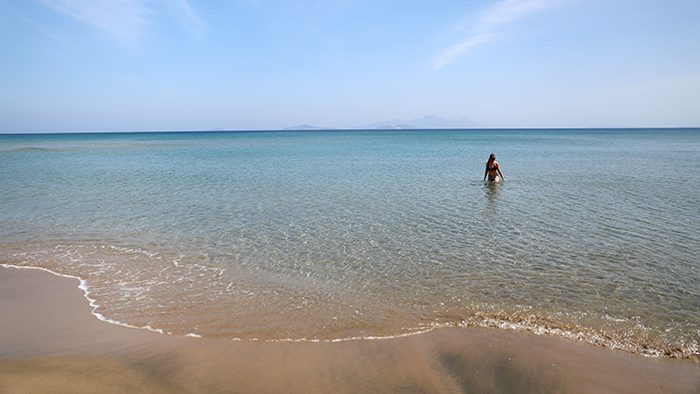
The island is sprinkled with archeological gems, some of which date back over 3000 years! These include castles, ancient temples, Roman theaters, and ancient agora. The Asklepion is perhaps the island’s most significant and well-known historical site. It is the oldest and most eminent healing centers of the ancient world. Dedicated to the god Asklepius, son of Apollo and god of medicine and health, the Asklepion functioned as a therapeutic complex well into the Roman era.

Kos’s culture has evolved out of its rich ancient heritage, the fact that it has changed hands numerous times, and its close proximity to Turkey. During the early years, Kos and Turkey enjoyed a friendly, logistical relationship oriented around trade. However, this soon evolved into a coveting on behalf of the Ottoman Empire during the Middle Ages. Kos eventually fell to the Ottomans, and today their influence can be seen clearly in the architecture. This somewhat rocky history is now overlooked in the interest of tourism, since visitors to Kos enjoy daytrips to the Turkey via the Kos Town’s ferry service.

Located just off the western coast of Turkey, a coastal view of Kos boasts crystalline waters back dropped by fertile, mountainous terrain. The third largest island of the Dodecanese Greek island chain, Kos’s geography and landscape are amongst the most convincing reasons to visit the island. The fresh island air has a seductive quality; while the relaxing sunshine, picturesque mountain villages, and pristine beach towns are frequently the top choice for honeymooners and vacationing couples.

Kos’s climate is classically Mediterranean. Hot summers and mild winters make planning a visit to Kos easy. You can count on sunshine between May and October, with the hottest months being July and August. During this time temperatures can reach as high as 95 degrees Fahrenheit! January is Kos’s coldest month, with temperatures ranging from 41 to 55 degrees Fahrenheit. Kos is beautiful year round, but tourism does die down quite a bit outside of the summer months. Budgeters should note that off season rates are more economical and can apply as late as June. Here are the top things to see and do in Kos Island. Lets begin with Kos Town!
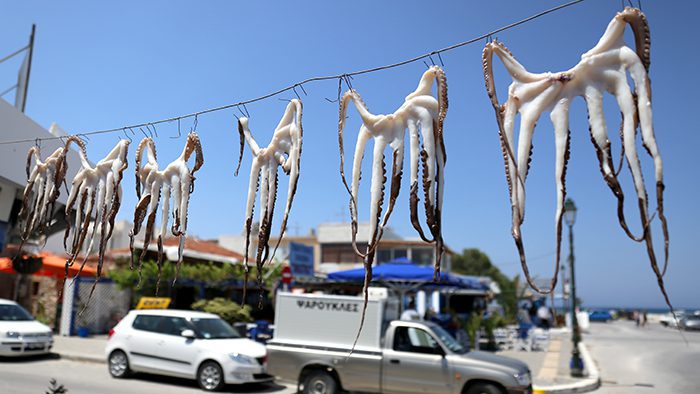
Located directly in front of the Castle of the Knights is the famous Hippocrates Plane Tree. Hippocrates is recognized as the founder of modern medicine, and is renowned as the most respected doctor of the ancient world! Born in Kos in 460 B.C., he was also known for his philosophies and humanitarianism. To this day, medical graduates from around the world recite the Hippocratic Oath and use it as a guideline in their medical practices. The Medical School of Kos houses roughly 60 volumes of writings by Hippocrates.

The Hippocrates Plane Tree is famous for being the tree that Hippocrates allegedly taught under. It is one of the oldest in the world, and one of the largest in all of Europe with a perimeter of over 39 feet. Locals believe the tree to have been planted by the father of medicine himself. According to local legend, the Apostle Paul also employed the tree’s shade for his lessons. It is at the epicenter of many of Kos’s cultural festivities during the summertime. Seeing the tree is free of charge.

The Nerantizia Castle, affectionately dubbed Kos Castle by locals and visitors alike, dominates the island’s main harbor and Kos town. It is the first thing that you notice as you approach the island by boat, and what a rewarding view it is! The castle was built by the Knights of Saint John during their reign between 1314 and 1512. The exterior was at long last completed in 1524, while the exterior was not completed until 1748.

Nerantizia was strategically built adjacent to Halikarnassos Castle on the Turkish coast. The two were in cahoots to control the straits between Turkey and Kos. Inside Nerantizia, many structure are still intact. The most impressive sections are the Tower of Del Caretto in the southwestern section, and the main entrance with its three arched bridges and mobile gate.

Tourists should not miss the opportunity to experience the castle first-hand and have uninhibited access to the entire perimeter. Be sure to bring a camera because Nerantiza offers panoramic views of Kos harbor. The castle is open daily from 8 a.m. to 7 p.m., and Mondays from 1:30 p.m. to 7 p.m. Admission is €3.

The Ancient Agora, or marketplace, is an excavation area comprised of a series of ruins dating back to the fourth century B.C. It is conveniently located next to the port, and bordered by a wall that is over 60 feet in length and eight feet tall. Once the island’s main trading center, the Agoria features the ruins of a temple that was possibly dedicated to Hercules, and a shrine to Aphrodite.
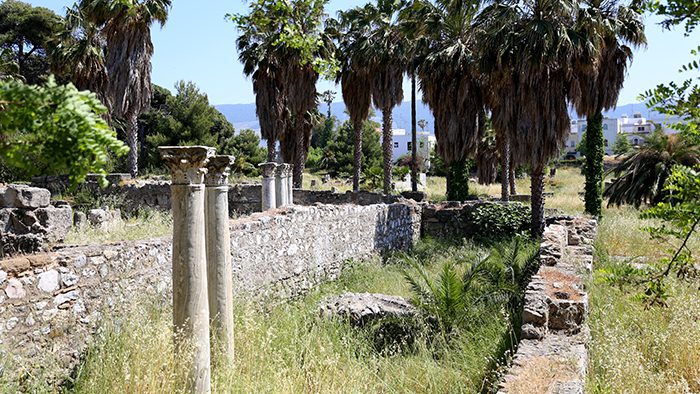
The columns of the stoa, or covered walkway, date back to the third century B.C. The actual market that once dominated the area was strategically located next to the port, Kos Town, Kos’s economical backbone. The Agora was the perfect spot for trading and the movement of local goods. The Agora ruins are located to the south of the Kos Castle and next to what the locals affectionately refer to as “the bar street.” The Agora is open daily and admission is free.

Kos’s Roman Odeon is a famous theater dating back to the second or third century. Standing amongst the rows, it is easy to imagine the grandiosity of the theater’s prime. According to ancient inscriptions, the theater replaced the precedent public building that was once used for assemblies and served as the council chamber. It was constructed between the first and second century A.D. for the purpose of hosting music competitions, concerts, and theatrical performances.

During its glory days, the Odeon was roofed and had seating for up to 750 people. Many of the original front rows are still intact, though much of the site has undergone a great deal of restoration. The first nine rows were carved of marble and reserved for royalty and higher classes, following rows were carved of granite and designated for people of a lesser social status.
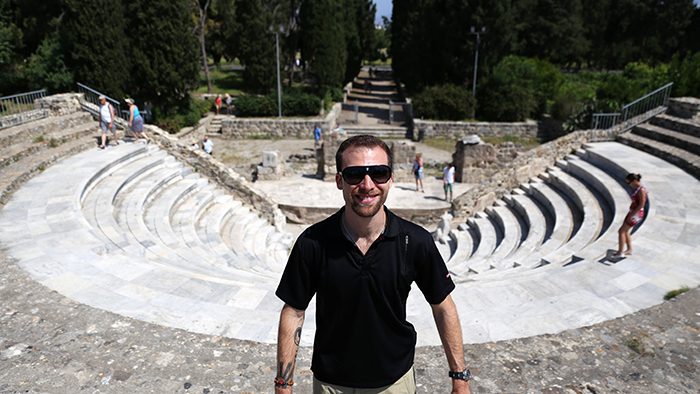
In 1929, the excavations were carried out by an Italian archeologist, and restorations continued well into the 1990s. There is a small museum on site that features before and after pictures, as well as images of the damage from the 1933 earthquake. There are also ruins of a nearby bathhouse and Roman gym that were discovered along with the theater in the early 20th century. Visitors should keep in mind that the steps are steep and may present a challenge for people with mobility issues. A visit to the Odeon is easily combined with a visit to the nearby Roman villa, Casa Romana. The Roman Odeon is open daily and admission is free.

The neoclassical building that houses the Archaeological Museum of Kos was constructed in 1935. Located in the Eleftherias Square, it is easily identified for its distinctive architecture. The museum displays findings from the 20th and 21st century excavations of the islands of Kos and Rhodes, as well as some of the smaller Dodecanese Islands. The findings cover an impressive timespan, across Hellenistic, Roman, and Venetian times. Among the displays are mosaics, statues from the Asklepion site, prehistoric pottery and metal objects, and gold coins.

Famous pieces include a statue of Hippocrates, pieces of the heads of Alexander the Great and Demeter, a mosaic illustrating Dionysus, and the statue of Diana and Asklepius. Many of these pieces are in remarkably excellent conditional. The museum often hosts educational programs to orient students and visitors within the extensive history and unique culture of the island. The museum is open daily from 8 a.m. to 8 p.m., closed on Mondays. Admission is €3.
Now we head around the island:
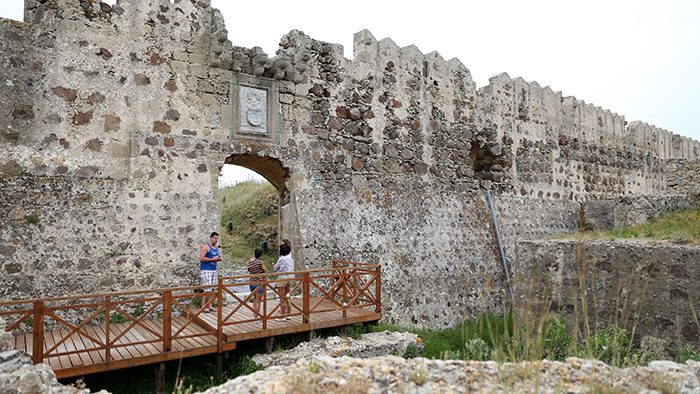
Located two and half miles outside of Kos, the Asklepion is the most celebrated archaeological site on the island. It was the healing center of the Greek god Asklepius, son of Apollo and god of medicine. Often referred to as a “Jesus Christ figure,” Greek mythology states that Asklepius was capable of raising the dead and healing sick people by appearing in the form of a serpent in the night. The symbol of a snake wrapped around a scepter is known as today as the universal symbol for medicine.

The Asklepion in Kos, though not the only one of its kind, is one of the largest ancient healing centers of the ancient world. It served as a sanatorium dedicated healing the sick with natural remedies and restorative therapies.

Hippocrates himself taught here, along with many other significant historical figures. Excavations began in 1902, and uncovered the four levels that comprised the Asklepion, one of which was used as a spa. Nearby springs from Mount Dikeo supplied the healing waters for patients. Visitors will be able to walk freely around the large complex admiring the ruins.
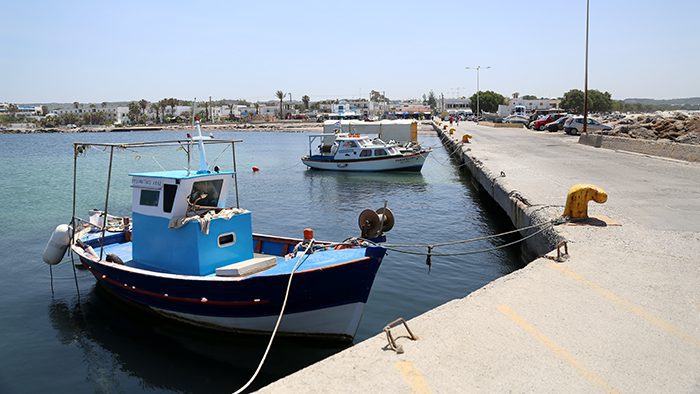
Allow at one and a half hours to visit the Asklepion. Bathrooms and a small café are located near the entrance for your convenience. Hours of operation are Tuesday to Sunday from 8:30 a.m. to 3 p.m. (closed on Mondays). Admission is €4.80. Parking is free.
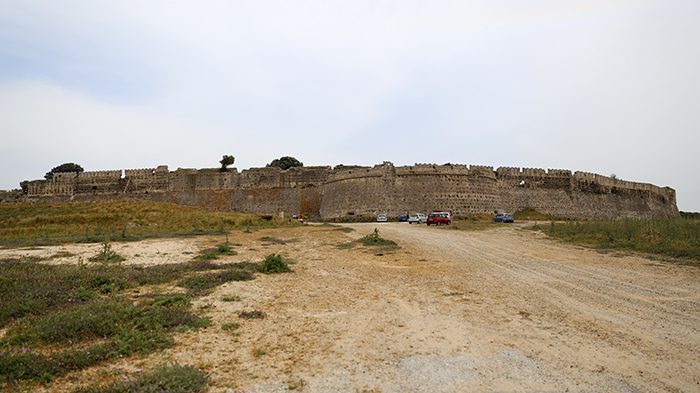
The Castle of Antimachia rests scenically on a hill overlooking the village of Antimachia. Constructed in the 14th century by The Order of The Knights of Saint John around the same time as Nerantzia Castle, the exterior fortifications have extraordinarily withstood the centuries and numerous attacks. This is largely due to its strategic location amongst rugged terrain and ravines. Construction was completed in the 15th century, with the only entrance to the castle located on the northern side. The entrance is protected by impressive double gates and marked with a marble relief of the emblem of the Order of Saint John dated 1494.
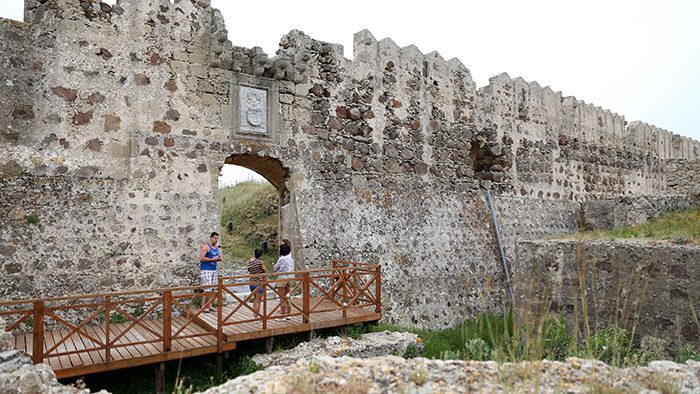
The remains inside of the castle are sparse, though the two Venetian churches, Agios Nikolaos (16th century) and Agia Paraskevi (18th century), are definitely worth exploring. There are limited remains of cisterns and dwellings, though there is little left other than their foundations. A visit to Antimachia gives a glimpse into some of the more exciting aspects of Kos’s fascinating history, as well as some pretty impressive views of the strait that separates Kos and Turkey.
Check out 3 Great Day Trips from Kos Island

The castle is not shaded, so during the summer months it is best to visit in the early morning or afternoon to avoid the midday heat. If you have some spare time, consider stopping over in Antimachia village. It is characterized by its traditional narrow streets and numerous windmills.

Located twenty-five miles to the south of Kos Town and accessible via the public bus system, is the treasured traditional town of Kefalos. It is an attractive town that stretches down a hill on the west side of the island, bookending the island with Kos Town in the east. Perfect for those looking for a more tranquil retreat, the quaint narrow streets are lined with houses and churches built in the charmed style of traditional Greek architecture.

The Traditional House, named for its architecture, houses a folk museum that displays pictographic recreations of the town during its formative years, complete with windmills and the neighboring castle as it would have appeared during its glory days. Today it is a sleepy, yet bustling little town with only 2,500 permanent residents, many of whom make a living off of the town’s thriving tourism industry.

Every year in February and March Kefalos hosts its own carnival, where both international and Greek tourists flock to enjoy local cuisine, drinking, and dancing. Additionally, Kefalos hosts the annual Festival of Tratas where ouzo, a typical Greek anise beverage, is honored. Kefalos Beach distinguishes itself from Kos’s other beaches with its stunning backdrop of the islands of Agios Theologos and Castri.
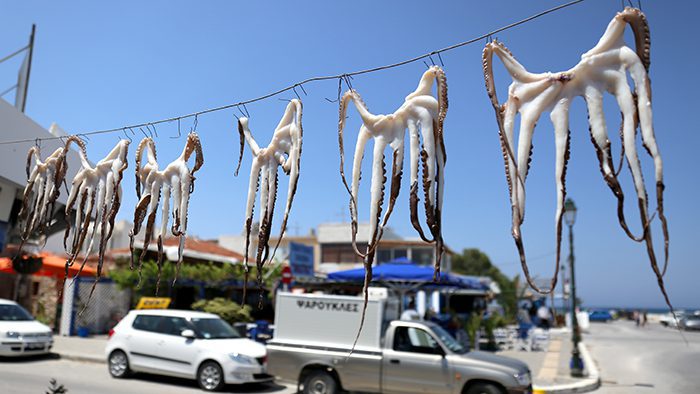
Situated roughly two miles from the town of Antimachia and just 14 miles from Kos Town, is the port town of Mastichari. It is an excellent place to sample fresh seafood in one of the local tavernas. Fishermen fill the harbor daily in order to provide the local tavernas and surrounding villages with their daily catches. The annual Mastichari Wine Festival, held every August, is a big hit with tourists. As Mastichari’s signature cultural event, it is perfect for those with an appreciation for homemade wines, and an enthusiasm for Greek delicacies and music.

A short distance inland is one of Mastichari’s most praised architectural gems, the Early Christian Basilica. Its most notable feature is its beautiful mosaic floor. Mastichari Beach is appropriate for swimming, sunbathing, and watersports. There are a wide array of watersports, though its choppy waters are most commonly praised by windsurfers.

Those looking for some family fun should consider heading to Mastichari’s Lido Waterpark. Attractions include a lazy river and a wave pool, both of which are ideal for patrons of all ages. Adults will enjoy their one of a kind therapeutic fish pool or the Jacuzzi. Mastichari serves as Kos’s gateway to the island of Kalymnos, with ferries departing daily out of the port. Local buses run daily from Kos Town to Mastichari.
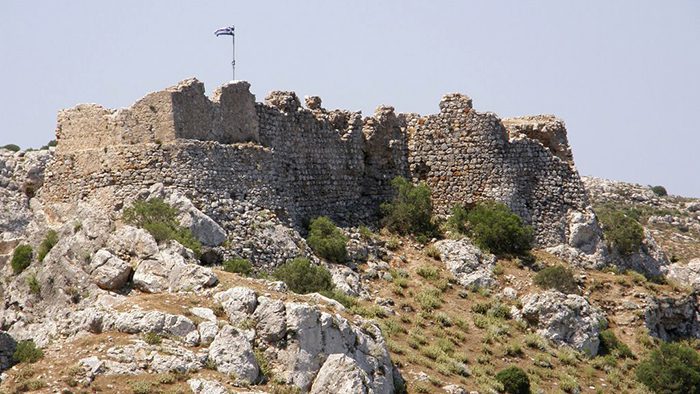
Pyli is a sleepy island village with a small local population. Near the main square is the Pyliotiko Spiti, a traditional house that has remained practically untouched for the last 70 years. It has only three rooms: a kitchen, living room, and bedroom, which give visitors a feel for what it was like to live on Kos before the island’s development and boom in tourism.
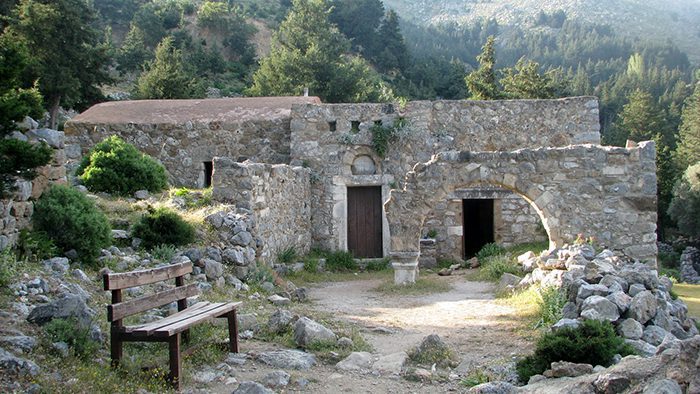
The town of Pyli itself has little to offer outside of its charisma, spring water fountain, Pyliotiko Spiti, and the charming main square with its coffee houses and tavernas. However, just a short distance away are the ruins of Old Pyli. Drive as far into the hills as you can, then ditch the car and trek up for approximately 30 minutes. Keep in mind that the hike is quiet steep and may pose a challenge for some!

Here you will see some remarkable ruins, including the old Crusader’s Castle. The castle was constructed by the Byzantine Empire during the Macedonian Dynasty, which ruled Kos from the 9th to 11th centuries. It was later used by the Knights of Saint John as a defense station. Excavations and restorations are still taking place today.

Plaka Forest is a five-minute drive from the Kos airport. Lucky visitors will have the opportunity to see the hundreds of peacocks and tortoises that roam freely throughout the shaded park. This peaceful pine tree forest rests in a gorge that stretches down to the sea.
Check out Top Things to See and Do in Athens

Great for families, it has an abundance of picnic tables and room to play. Organize a BBQ, search for peacock feathers, or enjoy the fresh air tinged with the scent of pinecones. A thirty-minute drive from Kos Town, it is easy to find via the main road heading towards Kefalos. When you drive in, you can park your car for free. Plaka Forest is open daily from sunrise to sunset.

Zia Village is located ten miles southeast of Kos Town nestled away in the lush foliage of the forest that stretches up the expanse of Dikeo Mountain. Zia is home to the oldest watermill on the island and is famous for its pink sunsets. Its stunning location makes it a big hit with both international and Greek tourists. Zia is a traditional mountain village and the ideal place for sampling authentic Greek food at one of the local tavernas, of which the best are centered around the main square.
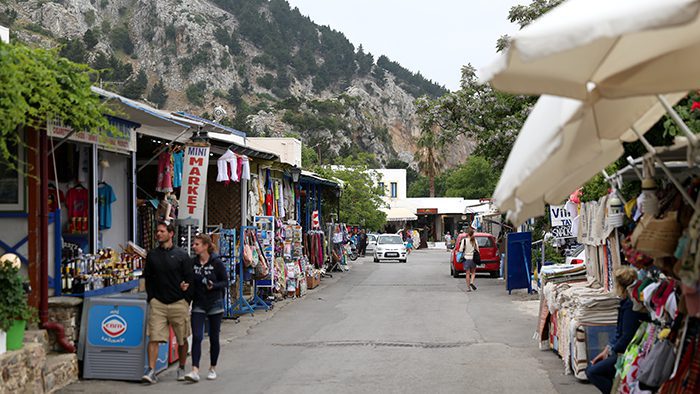
Three churches greet you at the entrance to the village. Shortly thereafter you will come to Zia’s main street, which is lined with mom-and-pop stalls selling everything from infused olive oils to natural sponges. Thyme honey is a regional tradition. Many shops offer free samples, so there is no excuse to not try this local treat! From the village, there is a road leading up to the highest point on the island. From here visitors can take in stunning views of all of Kos.
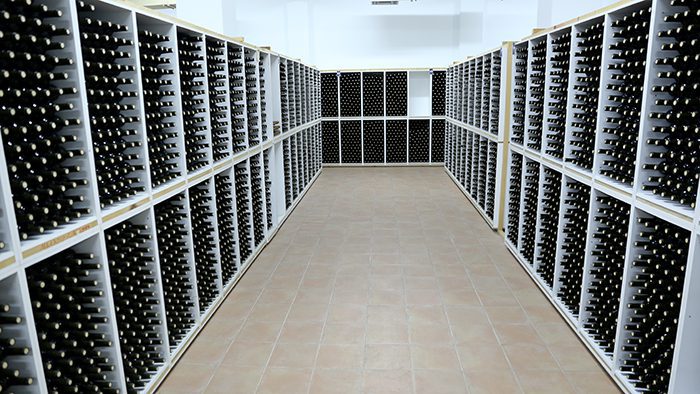
The people of Kos are tremendously proud of their winemaking heritage, and with good cause! Kos has been producing wine since well before 500 B.C. In fact, Hippocrates himself advised of the health benefits of the responsible consumption of wine. The island’s rich volcanic soil is perfect for growing grapes. Many of local wines are sought out by wine connoisseurs, and some have even won international awards.
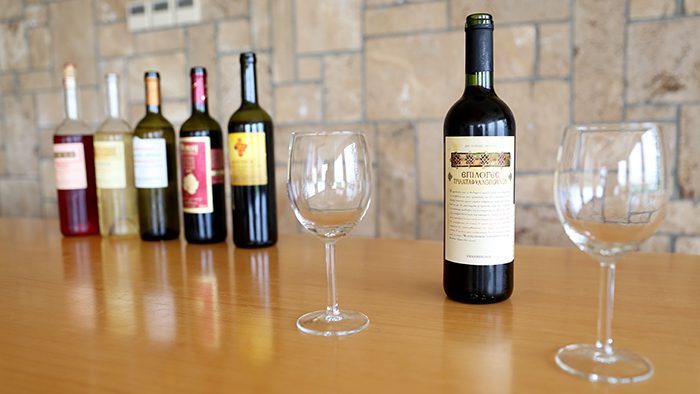
Triantafyllopoulos Winery is located in Miniera near the village of Asfendiou. The winery grows indigenous and cosmopolitan grape varieties on its expansive, picturesque 50-acre estate. The soil of this region is said to be the most suitable and fertile of the island, and the Triantafyllopoulos family is dedicated to their craft. A trip to the vineyard is ideal for both wine enthusiasts and those who are interested in better understanding Greek culture and heritage.
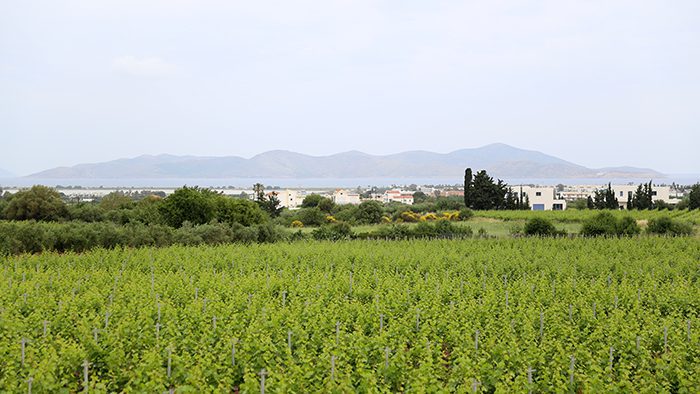
Only a handful of these wines leave the island, and most are virtually impossible to attain outside of Greece, so be sure to stock up on your favorites before heading home. Tours are available and visitors should not miss out on the opportunity to try their coveted Malagouzia Sauvignon Blanc. The winery is open Monday to Saturday until 3:30 p.m.

Camel Beach got its name for the large rock on the shoreline, which, when viewed from the sea, resembles a camel. The waters are calm and ideal for swimming if you do not mind that they are a little cold. The beach itself is somewhat off the grid, though there is nearby parking and a few beach chairs with shading umbrellas.

Kardamena is amongst Kos’s most popular beaches. It offers a wealth of watersports opportunities and a warm stretch of white sand beach. Kardamena village is quaint, with clusters of houses pushed right up against the short line, and docks lined with local fishing boats. Additionally, the archeological site The Temple of Apollo is nearby.
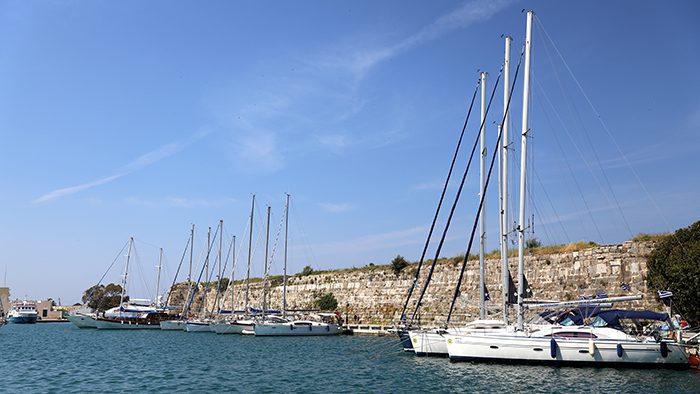
Paradise Beach is located adjacent to the village of Kefalos, and roughly 19 miles from Kos Town. The shoreline has plenty of sunbeds and umbrellas, as well as a watersports center. Paradise’s waters are beautiful, warm, and clear. Sometimes referred to as Bubble Beach, visitors should consider snorkeling to see the underwater bubbles resulting from the active volcano of Nisyros Island.

Therma Beach got its name for its natural hot spring. The beach itself is quite short and lined with dark pebbles with the spring located at the far end. Its waters are therapeutic and can reach temperatures as high as 108 degrees Fahrenheit. Wear a dark bathing suit since the water tends to stain your clothing. Visitors must walk 15 minutes downhill to reach the shoreline. Mules are available.
 Situated just shy of seven miles from Kos Town, Tigaki beach is framed by calm, clear waters and a myriad resorts, restaurants, and shops. There are plenty of sunbeds and umbrellas available, and its shallow waters are perfect for small children. It is popular amongst the locals, and there are plenty of watersports opportunities for the more active visitor.
Situated just shy of seven miles from Kos Town, Tigaki beach is framed by calm, clear waters and a myriad resorts, restaurants, and shops. There are plenty of sunbeds and umbrellas available, and its shallow waters are perfect for small children. It is popular amongst the locals, and there are plenty of watersports opportunities for the more active visitor.
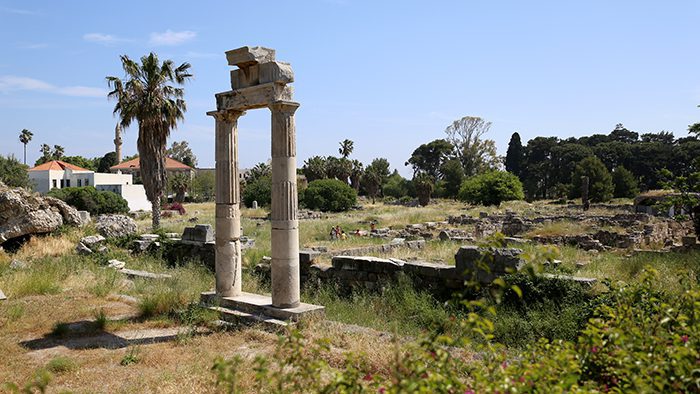
Nine miles to the west of Kos Town and just two and half miles north of Pyli is the relaxing beach of Marmari. Marmari’s warm sands and waters tempt the lazy sunbather with a day of relaxation. The shoreline is home to a number of tasty tavernas and companies offering waterspouts.
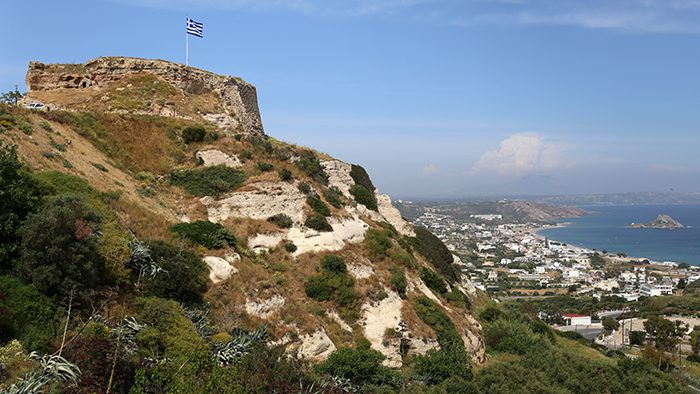
If you’re planning a Greek island getaway, be sure to add Kos to the list! Though small, Kos has a distinguished history and many ancient sites to admire. The island’s heritage is namely associated with Hippocrates, the father of western medicine. Here, Hippocrates was born, raised, and taught many of his pupils under a Plane Tree, which still stands today in Kos Old Town. This quaint historical district is a great place to spot Hellenistic and Venetian-era buildings. Venturing further from Kos Old Town will reveal Roman-era constructions and the island’s most impressive ruin, the Asklepion.
Kos is home to a healing center dedicated to the Greek god Asklepius, the god of medicine. The amazing Asklepion was one of the world’s first hospitals and strategically built near natural water springs, which the ancient Greeks believed possessed healing properties. Visitors can tour the grounds and get an idea of how modern medicine began to evolve.
For lovers of sand and sea, Kos does not disappoint. The island boasts stunning beaches and lovely harbors. Therma Beach is especially impressive with its stark black pebbles and natural hot springs. A day trip to a couple of traditional villages is a great opportunity to taste authentic, delicious Greek food and shop for souvenirs. Of all the activities that I experienced during my trip here in 2013, Plaka Forest and Triantafyllopoulos Winery were my favorites. Who knew you could spot a peacock, do a wine tasting, and go swimming all in one day?
Time zone: GMT +2:00
Official language: Greek
Currency: Euro (€)
Currency converter: XE
Getting there: Kos can be reached by plane or ferry. The Kos International Airport Hippocrates is conveniently located in the center of the island. Olympic Air and Aegean Airlines offer daily flights from Athens. During in July and August, Astra Airlines offers the additional service of flights from Thessaloniki. Ryanair offers year round flights from Frankfurt-Hahn and Milan-Bergamo with rates as low as €30 for a return flight. Bus schedules from the airport to Kos Town and Mastichari revolve around Ryan Air flight schedules. Ferry services are available from neighboring islands: Piraeus, Rhodos, Patmos, Leros, Kalymnos, Santorini and Syros. You can also take a ferry from one of the nearby Turkish coastal towns of Bodrum and Datça. From Turkey, a one-way fare will cost between €28 and €30 and a valid passport is required for travel. During winter months, visitors should keep in mind that they will have to contend with a reduced ferry schedule.
Getting around: All the sights in the Old Town are walking distance from each other. Parking can be a bit of a challenge since many of the streets are one-ways and the historical district wasn’t built for cars. The good thing is that once you do find a space, parking is free. Bicycle rentals are a popular method of transportation, especially when visiting the Roman Theatre, which lies just outside the Old Town.
Public bus transit is inexpensive and reliable. Stops on the bus route include Kos Town, Zia, Mastichari, Antimachia, Kardamena, Kefalos / Paradise Beach, Tigaki, Pyli, Marmari and the airport. Tickets are always purchased on the bus.
The island’s Tourist Train offers twenty-minute guided tours around the island, starting at the Municipality Building and working its way through many of the main attractions: the main square, marina area, beaches, incredible view points, and ancient sites. The train runs daily from 9 a.m. to 5 p.m. except on Mondays. It is five euros for a two-way ticket, and can be purchased as you board.
Taxis are available 24 hours a day and fares include taxes. Expect to pay approximately €34 one-way from the airport to Kos Town. Since transportation costs can really add up, we suggest renting a car if you plan to see more than Kos Old Town.
Inter island travel: Kos is connected with Piraeus (Athens), Kalymnos, Rhodes, Nisyros, Astypalea, Tilos, Paros, Naxos, Patmos, Leros, Syros and Kastelorizo with Blue Star Ferries. Another large carrier is Dodekanisos Seaways, which operates two different schedules:
Amorgos Ferries connects Kos with Symi, Tilos, Nisyros, Rhodes, and Kalymnos. Finally you can get on local boats, which depart from Kos and head to neighboring islands of Nisyros, Kalymnos, Ikaria, Fournoi, Leros, Agathonisi and Astypalea. The local boats do not follow the schedules of the larger carriers and will oftentimes transport travelers in times of bad weather when the larger carriers will not.
Please specify if you will be traveling with your vehicle at time of booking. In many cases, the ferries are first come first serve, so pre-booking is not required; just show up to the port an hour before your ferry to purchase your ticket. For more information, contact the Kos Port Authority.
Yacht charters: Kos is an excellent starting point from which to charter a yacht, catamaran, or sailing boat to see the rest of the Dodecanese islands. There are excellent yacht sales in Greece.
Business hours: Standard business hours are Monday to Saturday from 8 a.m. to 2:30 p.m. and then from 5:30 p.m. to 8:30 p.m. Most businesses are closed on Sundays. In Kos Town and during high season (summer), these hours may be longer. Banking hours are Monday to Thursday from 8 a.m. to 2:30 p.m. and Fridays from 8 a.m. to 2 p.m. Larger and international branches may have evening and Saturday hours.
Shopping: Kos Island is best known for its wine and local delicacies. Consider picking up some local wine at Triantafyllopoulos Vineyard, or a jar of thyme honey in the village of Zia. Diehard shoppers should consider heading to Bodrum, Turkey for a day to take advantage of their rock-bottom prices on designer-inspired merchandise and arts and crafts in the Tuesday market and the pedestrian-friendly Old Town Bazaar.
Electricity: 220-240 Volts. Electrical sockets take the European 2-pin round plug. For 110-120 V (U.S. and Canada) appliances, a plug adapter, and in some cases a voltage converter is required.
Best time to go: The most popular and hottest months to visit are July and August, though tourist season is officially May through October. During low season, rates are often more economical. Reduced rates are sometimes offered as late as June.
Did you enjoy our list of things to see and do in Kos Island, Greece? Leave us a question or comment below!
Counter
101 Countries • 1432 Cities
Jill Jeffrey says:
Thanks, informative and helpful as we can’t decide which island to visit this year and we like good beaches tavernas historical sights and cycling.. Never wanted to go to Kos and now I think it may well be the one we visit this year. Thanks
Mags says:
Really enjoyed your information on kos. Planning a trip in early October. Thank you.
David says:
You’re welcome Margaret! Hope you had an amazing trip 🙂
Dina Astras says:
My husband’s family is from Kos but they go there more as a local than a tourist. My kids and I might finally come with my husband in Spring. I am not sure about the temperature of the water in Spring so I have to keep my kids busy with other things not involving swimming in the water. Thanks for this post. I’ll let you know when I get back.
David says:
Hi Dina, Thanks for stopping by! I have no doubt the water will be freezing but kids sometimes will surprise you with what they’ll take to have some fun in the ocean 🙂 I hope you have a great time there with your family, I am sure you will love it especially since you have locals to show you all the best spots. My wife’s family is from Kalymnos – an island very close by that’s easy to reach by a short ferry ride. That would also be a day trip option if you wanted to keep the kids busy. I would love to hear how th trip went when you return. Safe travels!